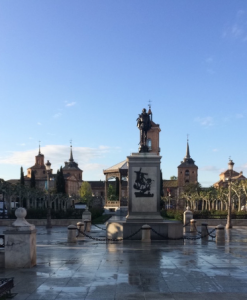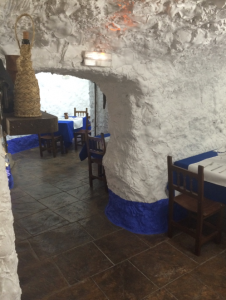Nick Browning
H-SC May Term Abroad
Madrid, Spain
Summer 2016
My First Week Back
I have been lucky enough to be able to return to Alcalá de Henares for the second time during my career at Hampden-Sydney. We are lucky that we are able to return to the historic town and study at one of the oldest universities in Spain: La Universidad de Alcalá de Henares. When I came back, I felt like I never left. The town hasn’t changed at all over the past two years, and with laws in place that maintain the historic feel, I don’t see much change happening any time soon.

The town has a rich history that includes being the cite of the birthplace of the famous author Miguel de Cervantes, the first meeting between the Catholic Kings and Cristopher Columbus, and the creation of the first Spanish grammar books used to teach the language to natives in the new world. However, it is very much so a modern city. Once you venture away from the center of town and the countless historic buildings and churches, Alcalá becomes much more modern.
On my 20-minute walk from my host family’s piso (apartment) to the school, I walk by other apartment buildings until I reach the main road that I take all the way to the Plaza de Cervantes. On my walk there, I pass by everything from clothing stores to bakeries. The window of my favorite bakery is filled with freshly baked pastries and sometimes paying 1.50 euros for three of my favorites is too good of a deal to pass up. This is especially the case when I’m heading home for our siesta/lunch break in between classes.
I love the experience of living with my host family. My host mom, Tere, is always checking up on me when I’m in the house to see if I need anything, and she has constantly been reminding me that I can grab some fruit or yogurt whenever I want anything to eat. There’s absolutely no chance of going hungry. My host dad, Nacho, kind of reminds me of my own dad. He’s serious when it comes to work, but likes to hit the one-liner jokes. He’s constantly giving me a hard time, but it’s always in a lighthearted manner and makes me feel at home. I also have a little brother this time around. Pablo is 15 and most of our relationship thus far consists of us playing FIFA together on his PS4. Sometimes I’ll sit down at the kitchen table with my host mom or on the couch with my host dad simply to talk. It took me a couple of days to reacquaint myself with only speaking Spanish; however, the entire family was and continues to be extremely patient with me.
Despite the fact that I’ve been here before, it is still extremely difficult to get used to the eating schedule of Spain. Here, breakfast is not bacon and eggs; it’s coffee and a sweet pastry or cookies. I don’t usually eat either with breakfast back home, but I’m slowly getting re-accustomed with it. Another difference is, due to the fact that breakfast is so small, the first filling meal of the day is the lunch we eat around 2:30. Then we won’t eat a real meal again until about 9:00 or 9:30. This isn’t just my family, it’s the way the Spanish culture works. Another thing that is hard to adjust to is the way we dress. Everyday it is between 85-90 degrees during the hottest part of the day, but you’ll only see foreigners wearing shorts. I don’t understand it; it’s as if Spaniards just don’t feel the heat because they are always wearing pants and usually a long sleeve shirt. I tried to wear pants for the first couple of days in an attempt to assimilate, but it was way too hot for me.
So far we have visited Consuegra and Madrid. Consuegra is famous for its windmills that Don Quixote fought in Cervantes’ novel and the 1100-year old castle that sits between the windmills. We toured both and then we were able to explore through the modern town.

I use the term modern loosely, because Kyler Vela and myself ate in a medieval palace that had been converted into a restaurant. We took on the “when in Rome” attitude, so we paid 13 euros for a ration of Manchego Cheese from the region and then decided it needed to be paired with some wine from Consuegra. It was definitely worth it. When we were done, the owner took us inside the restaurant and showed us that the dining room in the back of the restaurant is made up of old caves that the Romans used to store their grains.
On our two other class trips thus far we went to Madrid. Every Sunday morning in the middle of Madrid, there is an open air flea market that takes over called “El Rastro”. There, you can buy anything from clothing to kitchenware and anything in between that you could imagine. We also went back this past Friday to see some of the major attractions of Madrid. With these being a feat that would take more than one day, we stuck to touring the Royal Palace of Spain and going to El Museo del Prado. In 2014, we were unable to go inside of Palacio Real; therefore, it was extremely cool to see the inside of it. It is beautiful from the outside, but the inside is unbelievable. After we toured a portion of the Palace, we made our way to El Prado. This museum houses art dating back to Roman times up until the start of the 19th century. My favorite painting, El Jardín de las Delicias, is housed there, so I immediately made my way to go see it. I know we have more trips coming up as a part of the program, and I’m excited to see what other new things I learn this time around.
